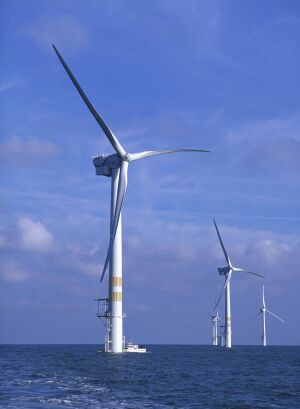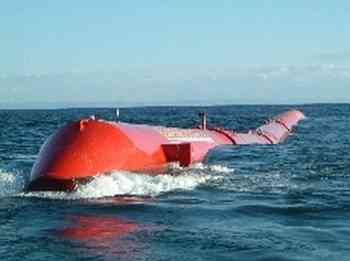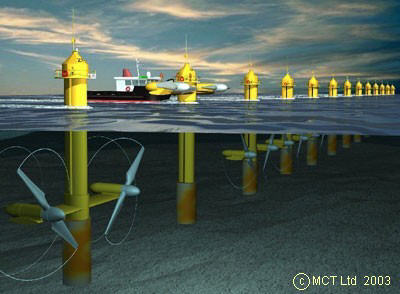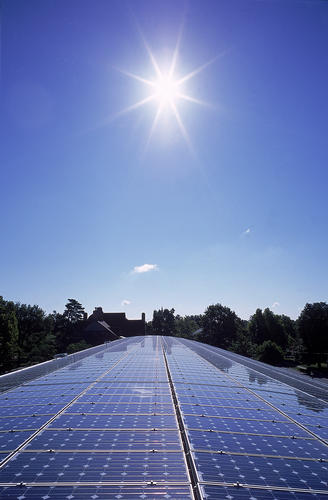ENERGY SUPPLY AND CONSERVATION
This page reviews renewable forms of energy and conservation of energy in
relation to various categories of sources and uses, and provides an assessment
of potential in each area (with sources of information and figures where they
are available). Much of the available information relates to electricity rather
than total energy demands but there is some discussion in sections below about
energy supply and conservation in areas such as transport and space heating
where electricity is not currently the main form of energy. Further information may be found in Energy UK.
It is becoming increasingly clear that renewable forms of energy, with
conservation of energy, can meet
current and anticipated future needs without undue cost and that we don't need nuclear power with all its many headaches. A growing number of reports show how it is feasible to make deep cuts in CO2 emissions without nuclear power. For example, the 'TRANS-CSP' report, commissioned by the German government, shows in detail, country by country, how Europe (including the UK) can meet all its needs for electricity, make deep cuts in CO2 emissions, and phase out nuclear power at the same time. A study from Pöyry Energy (Oxford) Ltd (PDF, 734 KB, August 2008) shows that the planned growth in renewable electricity in the UK, with energy conservation, can ensure adequate generating capacity in the UK until at least the mid 2020s.
On this website, a spreadsheet summarises the
sources and savings described on this page and shows clearly that current UK
demands for electricity can be met very easily, with plenty left over. Even allowing for the electrification of road transport (see Appendix 8 in Energy UK) and the use of electricity to power heat pumps for space heating, there is more than enough potential in renewable sources of power. For example, less than 0.3% of the area of the Sahara desert could meet all of the EU's electricity needs (see below) although any such source of power should be developed in conjunction with other renewable sources of power.
Given
that estimates vary, the figures that have been used in the spreadsheet are
marked on this page with the symbol: ▲. Generally speaking,
the more cautious figures have been chosen, except where there is evidence that
a given figure may be over-cautious.
While it is true that "the wind does not blow all the time", it is also true
that all sources of electricity are intermittent, including conventional
sources, and that demands for electricity are highly variable. There are techniques and technologies for managing this
variability in supply and demand and good reasons to suppose that it is much
less of a problem than sometimes suggested.
Links:
- Germany's coming energy revolution (Business Week, 2009-10-16).
- Sustainable Scotland (The Engineer, 2009-07-14). All of Scotland's electricity could be generated from renewable sources by 2030.
- Renewables and efficiency could plug UK energy gap (RenewableEnergyWorld.com, 2008-08-08)
This is the big one, quite capable by itself of meeting all the world's
energy needs. Using CSP, less than 0.3% of the area of the Sahara desert could meet all of the EU's electricity needs.
Every year, each square kilometre of sunny desert receives solar energy equivalent to 1.5
million barrels of oil. Multiplying by the area of deserts world-wide, this is several hundred times the entire current energy consumption of the world.
Using the proven technology of CSP, less than 1% of the world's deserts could generate as much electricity as the world is now using. Contrary to what is commonly
supposed, it is feasible and cost-effective to transport solar electricity over
long distances. Modern, highly-efficient HVDC transmission lines provide the
key.
How much?
The TRANS-CSP report suggests that 15%▲ of Europe's electricity could be supplied by imports of CSP electricity by
2050. This figure reflects caution about the planning and construction of CSP
plants and the proposed trans-Mediterranean HVDC transmission grid. But we
should not forget that Britain's railway network was built almost entirely in
the 20 years between 1830 and 1850 using little more than picks and shovels.
With the right political and financial impetus, the system proposed in the TRANS-CSP report can certainly be put
in place. Given the huge amounts of solar energy falling on desert regions, and the
well-established technologies for capturing it as electricity and distributing
it, the UK could in principle obtain 100% or more of its electricity from this source.
 Wind power Wind power
Wind turbines are a well-developed technology and the potential is huge. The
UK has been estimated to have over 33% of the total European potential offshore
wind resource - enough to meet the UK's electricity needs three times over (BWEA
- offshore wind). There is similar potential in many other parts of the
world.
A common objection to wind power is that the wind does not blow all the time.
But a conventional power station is often shut down for routine maintenance or
because of unscheduled breakdowns. And the demand for electricity varies from minute to minute.
Although the
wind does not blow all the time at any one place, it is rare for the wind to
stop blowing everywhere across an area the size of Europe—so that
widely-distributed wind farms with grid connections give a much more stable
output than any one wind farm. Airtricity has proposed
a Europe-wide 'Supergrid' of highly-efficient HVDC transmission lines (see electricity transmission grids) to
reduce the effect of intermittency in wind power. Wind farms deliver more power in the winter, just
when it is most needed.
A fascinating idea is that 'Plug-in Hybrid Electric Vehicles' (PHEVs), which
appear to be the hot favourite with motor manufacturers for greening the road
transport system, will provide a means of ironing out peaks and troughs of
supply and demand in the electricity distribution grid. This is explained in the section on PHEVs.It is sometimes argued that the gains from wind farms are cancelled by the
need to provide 'spinning reserve' in conventional power stations to cope with
the intermittency of wind power. This argument is false: what matters is that
there should be a mixture of 'base load', 'intermittent' and 'peaking' power so
that the whole combination can cope with variability in the system, both in
supply and in demand. This is well explained in the TRANS-CSP report (on page 10 and
elsewhere).
Although the wind does not blow all the time, wind power could, in principle, provide us
with a high proportion of the electricity we use. How is this possible? When there is more
wind power than we need, the surplus electricity may be used to generate hydrogen
which is stored. When the wind drops, the stored hydrogen may be used as fuel for an
engine that drives an electricity generator. It is true that energy is lost as
heat in this process but, using CHP,
much of this 'waste' heat may be used for space heating. For further
information, see wind
and hydrogen and energy transformation and
transportation, below.
Another common objection to wind power is that "several thousand wind
turbines would be needed to produce the same energy as a conventional power
station". But the London Array wind farm that has been proposed for the Thames Estuary will have 271 turbines and these
will produce up to 1000 MW of electricity—approximately the output of a small-to-medium-sized
conventional power station.
How much?
It is generally accepted that 20%▲ of the UK's electricity may
be met from wind power without the need for any significant provision for the fact
that the wind does not blow all the time (see BWEA myths about wind power).
In principle, 100% or more of the UK's electricity could be met from
wind power but there would need to be greater provision of techniques and technologies for managing the
variability in supply and demand. A report from the European Environment Agency (Europe's onshore and offshore wind energy potential, PDF, 3.5 MB) calculates that the "economically competitive potential" of wind power in Europe comfortably exceeds projected demands. Another report, from the US National Academy of Sciences (Global potential for wind-generated electricity, PDF, 1.9 MB) calculates that wind power could supply more than 40 times current worldwide consumption of electricity and more than 5 times total global use of energy in all forms.
Links: floating wind farms
Links
- Crown Estate: Round 3 of offshore wind
- Smoothing out the wind (The Economist, 2010-03-15).
- Optimism in offshore wind (RenewableEnergyWorld.com, 2009-12-09).
- Wind could power Europe many times over (RenewableEnergyWorld.com, 2009-06-16).
- Surpassing expectations: state of the US wind power market (RenewableEnergyWorld.com)
- Wind and hydrogen
- Anglesey Wind and Energy Wind Hydrogen Ltd
- "Hydrogen
Enables Storage of Excess Wind Power in Spain"
- British Wind Energy Association
- yes2wind
- Airtricity
Marine
Links
 Wave power Wave power
The disastrous effect of the Asian tsunami demonstrated in a
tragic way the enormous amount of energy that can be carried by waves. From at
least as far back as Stephen Salter's 'ducks', prototype systems have been
developed for capturing the energy of waves. One of the most promising at
present is the Pelamis 'sea snake' comprising a jointed tubular structure designed to float on the sea, flex with
the waves and capture the wave energy by means of hydraulic rams, turbines and
generators. Each single 750-kilowatt Pelamis could generate the same amount of
power as a land-based wind turbine and a 'wave farm' covering a square kilometre of ocean
would provide enough electricity for 20,000 homes.
How much?
Ocean Power Delivery say
that "There is sufficient energy breaking on the UK shoreline to power the
country three times over. However, it is not practical to recover all of this
energy. The economically recoverable resource for the UK alone has been
estimated to be 87TWh per year, or ~25% of current UK demand." (see The Resource). Erring on the side of caution, we have assumed in our calculations that up to 20%▲ of UK demand could be met by wave power.
Links
 Tidal currents Tidal currents
Technologies have now been developed for generating electricity from the
energy in tidal currents (see links below).
How much?
From information in a report from Black &
Veatch,
the
Carbon Trust (The
UK tidal stream resource and tidal stream technology) say that "The UK
technically extractable tidal stream resource is ~18 TWh/year ± 30 %, which is
roughly 5% of current UK electricity demand." However, they add that the
"economically extractable UK resource" is about 3%▲ of current UK electricity demand. More optimistically, the Carbon Trust estimates that tidal streams could generate as much as 20% of the UK's electricity demand (see "The rise of British sea power", below).
Links
An attractive idea is to build lagoons in shallow sea water that generate
electricity from turbines powered by the flow of water into the lagoons as the
tide rises and out again when it falls.One attraction of this kind of system is that the energy is totally
predictable. With three or more lagoons grouped together, it is possible to
manage the flows of water using computers in such a way that peaks and troughs
in supply are reduced.Another fascinating aspect of tidal lagoons is that they can be used as
pumped-storage devices: water is pumped into the lagoons when there is more
electricity available than is needed and then it can be used to generate
electricity when demand is higher or when supplies from other sources are lower.
Neil Crumpton of Friends of the Earth argues that tidal lagoons in combination with tidal reefs could produce more electricity than the proposed Severn barrage and they would be more friendly to wildlife (see A Severn barrage or tidal lagoons?, January 2004; see also The Severn barrage, September 2007 and Severn reef plan is 'more green' (BBC News, 2008-11-26)).
How much?
Peter Ullman, Chairman and CEO of Tidal Electric,
estimates (personal communication) that 8%▲ of the UK's electricity could be met
from tidal lagoons.
How much from marine sources in general?
In its report Future Marine Energy the Carbon Trust estimates that
"Between
15% and 20% of current UK electricity demand could be met by wave and tidal
stream energy". Judging by the figures quoted above, that estimate is probably
too low.
'Micro' generation
There is a growing realisation that much of the electricity we use could be
generated domestically by photovoltaics, small-scale wind turbines, combined heat and power,
and fuel cells. Some of the possibilities are described on web
pages under the 'Links' heading.
 Photovoltaics Photovoltaics
Although PV panels have been expensive, there are improvements in the
technology and costs are falling (see SunPower, H-Alpha Solar and Flexcell). We may be approaching the point where it is feasible and
affordable to install PV panels on any surface that receives sunlight.
How much?
A report from the Tyndall Centre ("Renewable
Energy and Combined Heat and Power Resources in the UK", 2002) says: "ETSU
[Energy & Environment Research Programme,
now Future Energy Solutions]
estimates the practicable resource to be 266 TWh
in 2025 (calculated as electricity
generated by the application of PV to all surfaces of available domestic and
non-domestic buildings, allowing for 10% non-suitable surfaces and 25% shading,
ETSU 2000 p.141)." Since current UK demand for electricity is about 400
TWh, this estimate means that about 66% of the UK's electricity could be
generated by photovoltaics.
At that level, it would of course be necessary to make provision
for the fact that the sun does not shine at night. However, as with wind power
(above), it seems likely that up to 20%▲ of the UK's electricity could be
generated by photovoltaics without the need for special provision.
Links
- Photovoltaic energy payback time
(Renewable Energy Sources).
 Micro-wind power Micro-wind power
The EST report, "Potential for Microgeneration",
estimates that as much as 6%▲ of the UK's electricity could be generated by micro-wind turbines by 2050.
CHP and fuel cells
If CHP and fuel cells are run on bio-fuels they are a source of electricity
that does not release fossil carbon into the atmosphere. But even if they are
run on fossil fuels, their use can mean substantial savings in CO2 emissions compared with current systems—so they may be regarded as a
partially-renewable source of electricity.
Erring on the side of caution, figures from "Potential for Microgeneration"
suggest that as much as 16%▲ of the UK's electricity could be supplied from these sources.
Hydropower
In a report published in March 2010, the UK Environment Agency estimates that hydropower in England and Wales could generate approximately 1900GWh to 3660GWh, or approximately 1%▲ of the UK’s projected electricity demand in 2020.
Links
Enhance Geothermal Systems (EGS)
Enhanced geothermal systems—which should not be confused with ground-source heat pumps—means drilling to depths up to 10 km to tap into the energy in hot rocks below the surface. Water which is pumped down the bore hole returns hot enough to drive electricity generating equipment.
A report about EGS from MIT says (in Section 1-4):
By evaluating an extensive database of bottom-hole temperature and regional geologic data (rock types, stress levels, surface temperatures, etc.), we have estimated the total EGS resource base [in the US] to be more than 13 million exajoules (EJ). Using reasonable assumptions regarding how heat would be mined from stimulated EGS reservoirs, we also estimated the extractable portion to exceed 200,000 EJ or about 2,000 times the annual consumption of primary energy in the United States in 2005. With technology improvements, the economically extractable amount of useful energy could increase by a factor of 10 or more, thus making EGS sustainable for centuries.
Not only is the resource very large but, like CSP, geothermal power has the attraction that it can deliver electricity that is dispatchable.
It appears that there may be similar large potential for EGS in many other parts of the world, including the UK. EGS Energy estimates that there is potential in the UK (mainly in Cornwall) to produce over 35TWh per annum, or almost 10% of the UK’s electricity demand, for about 200 years.
Links
Geothermal and hydro-electric power from Iceland
Iceland generates 100% of its electricity from hydro-electric and geothermal sources and all of its space heating is geothermal.
There appears to be considerable potential for export of clean energy, either directly via HVDC submarine cables or indirectly by the siting in Iceland of energy-intensive applications such as computer data centres.
Links
Electricity conservation
The Friends of the Earth (UK) electricity sector
model for 2030 (A
Bright Future, March 2006) says "Around one
large power station, or two medium-sized ones in the UK have to be kept running
in order to provide power for appliances not in use and on standby mode. Replacing ordinary light-bulbs with energy-efficient
light-bulbs could reduce electricity consumption by at least 2 per cent▲ (equivalent to one nuclear power station) by 2020. The potential is much higher
if we implement a programme to replace inefficient street lighting and lighting
in the commercial sector." (pp 11-12). Although they do not give a percentage
saving for eliminating standby, the amount of energy that could be saved appears
to be similar to the 2%▲ figure quoted for switching to low-energy light bulbs.
In A
Bright Future, FoE says "Studies for the European Commission, and supported
by industry groups, have identified the potential to make significant cuts in
electricity-use and considerable financial savings by ensuring that industry
uses correctly-sized and super-efficient motor devices. These studies show a
potential to reduce electricity consumption by around 6 per cent▲ in the UK within a few years simply by encouraging a switch to more efficient
motor drives."
Links
Other ideas
- Energy Island. Ocean Thermal Energy Conversion (OTEC) on floating islands in tropical parts of the world.
Carbon capture and storage (CCS)
The German Aerospace Centre (DLR) has done an interesting study of CCS. Here are the main links for the project:
The main conclusions are that CCS is unlikely to capture more than about 80% of emissions, there will be losses in efficiency, the technology will not be available for some time, and it is liable to be expensive.
Transport
Road and rail transport
Electricity
Railways can be, and often are, powered by electricity and, if that is
'green' electricity, rail transport would also be green.
For road transport, electric vehicles and plug-in electric hybrid vehicles (PHEVs) are coming on to the market (see EVUK). As with rail transport, this can mean
that emissions of fossil CO2 from road transport may be completely
eliminated or substantially reduced.
What is not clear at present is how much electricity would be needed to power
the railways and all road vehicles. However, the fairly cautious figures that
have been quoted on this page and summarised in the accompanying spreadsheet suggest that there is considerable scope for powering road and rail transport by
green electricity.
Links
- Known lithium deposits can cover electric car boom (Planet Ark, 2010-02-12).
Biofuels
Biofuels can be made from crops that are grown for the purpose but there is a potential worry that this will divert
agriculture away from food production and it may lead to the destruction of
rainforests or other wild ecosystems to make way for oil-palm plantations or the
production of soya beans.
A much more attractive idea is to make biofuels from things that may
otherwise be wasted, like waste cooking oil, forestry or agricultural waste, old
packing cases, and so on.
In a public lecture at Bangor University on the 26th of June 2006, Richard
Parry-Jones, Ford Motor Company's global head of product development, quoted
research suggesting that, without destruction of rainforest, 20% of road fuels
could come from plants, assuming that food production was given priority over
the production of biofuels.
Links
Air
Air travel is a large and rapidly growing source of CO2 without
much sign of an acceptable carbon-free technology to solve the problem. Sir
Richard Branson of Virgin Atlantic Airlines is said to be interested in the
possibility of powering planes with biofuels but, as mentioned above, this could become a headache in its own
right. There have been experiments in running planes on hydrogen but we don't
hear much about that now.
 Shipping Shipping
In principle, all shipping could be powered by the wind, as it traditionally
was. Some of the modern options are referenced under the Links heading.
Links
The Internet
In principle, a lot of business travel can be eliminated by the use of video
conferencing via the internet. No doubt the internet will have to improve before
this kind of communication can be as good as face-to-face meetings but even now
there is clear potential for reducing CO2 emissions from business
travel, especially if there are incentives via carbon taxes and carbon rationing.
Buildings
In cold climates, a lot of CO2 is emitted by burning coal, oil or
gas to keep us warm. Much of this can be eliminated by using levels of
insulation that are much higher than have been traditional in the UK but are not
unusual in countries like Sweden or Canada (see also Zero-carbon eco-renovation and Domestic heating).
Residual heating needs may be met by the use of technologies such as passive
solar heating, ground-source heat pumps, bio-fuels, inter-seasonal heat stores, and more.
Solar water heaters can save a lot of the CO2 emissions currently
produced by using fossil fuels for heating water (about 4% of UK CO2 emissions).
Links
Industry
The smelting of aluminium requires large amounts of electricity. For example,
the power consumption of Anglesey Aluminium is 250 MW. Although this is large,
it can in principle be supplied entirely from renewable sources. For example,
with backup from the grid, the
projected offshore Gwynt y Mor wind farm in Liverpool Bay, with a peak output of
750 MW and a load factor of about 33%, would provide all the power needed by
Anglesey Aluminium. Marine
Current Turbines estimate that there is 150 MW of exploitable power from
marine currents near Anglesey and that would cover a large part of what is
needed by Anglesey Aluminium.
It seems likely that the needs of other power-hungry industries can also be
accommodated. Given the enormous quantities of solar energy
available in hot deserts, there may be a case for moving some of those
industries to the areas where they can get the power that they need.
Conclusion
The potential of renewable forms of energy generation, coupled with energy
saving, is huge. There is no need to return to nuclear power with all its
problems.
The spreadsheet on another page summarises the figures for electricity marked with '▲' on this page.
The main unsolved problem at present is how to power air transport without
the use of fossil fuels.
STOP PRESS: New
report shows how Europe can make deep cuts in CO2 emissions and phase out nuclear
power at the same time
|